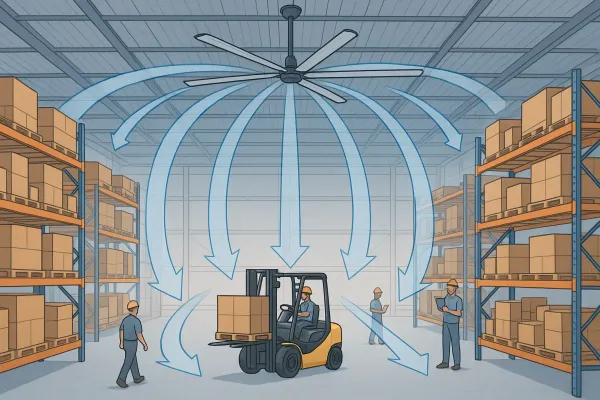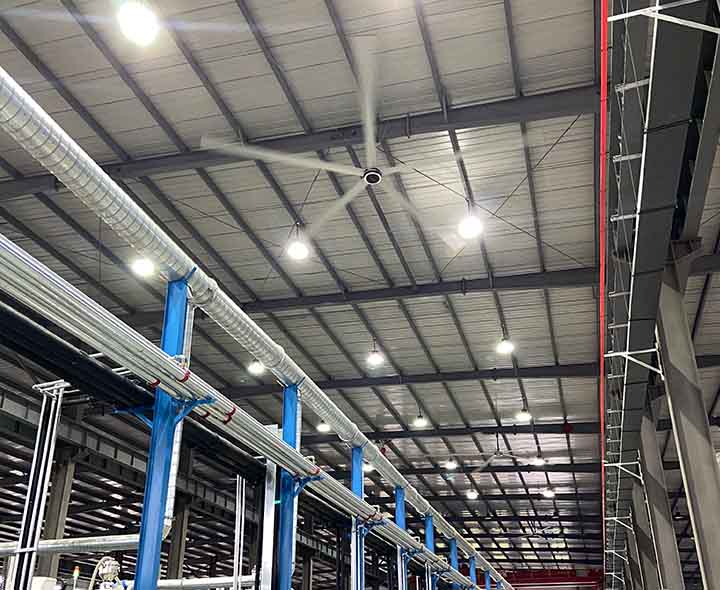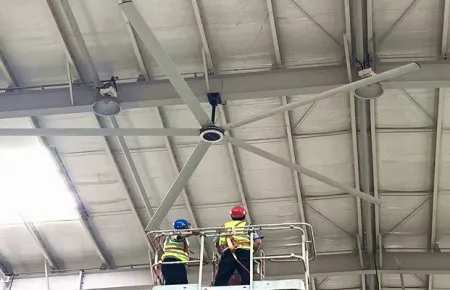Struggling with hot spots, stale corners, and rising energy costs in large spaces? Those issues drain comfort and productivity. Heat layers build up, air sits still, and utility bills climb. The fix is simple: plan air movement like a system, then size fans, blowers, and exhaust to fit your building and use.
Industrial air movement systems improve comfort and control while lowering operating costs by mixing air, removing heat and contaminants, and complementing heating and cooling. With the right industrial fan, ventilation, and exhaust solution, you reduce hot and cold zones, stabilize temperatures, and improve indoor air quality at a lower energy spend.

Industrial air movement systems
Industrial air movement solutions are the combined fans, blowers, ventilation, 和 排气 elements that keep large buildings healthy and efficient. In plain terms, they 移动空气 where and when you need it. A well-designed approach balances supply and exhaust to control temperature, humidity, and contaminants.
In a big warehouse or sports hall, warm air rises and collects 开销 while the floor stays cool. That vertical split wastes heating energy and creates discomfort. Proper air control uses large ceiling units to gently 流通 air down, plus dedicated exhaust systems designed to remove fumes and moisture at the source. The results are more even temperatures, fewer complaints, and lower 能源成本.
High Volume Low Speed (HVLS) ceiling units are the backbone of modern industrial solutions because they move a lot of air at low velocity. Their broad, slow-turning blades sweep huge areas, breaking up hot strata and distributing comfort with minimal power. In summer, occupants feel cooler due to increased air speed; in winter, the fans gently push warm layers down to the floor for thermal balance.
Independent and industry reports show that destratification fans can cut winter heating fuel use in warehouses by around 19 percent, and in some hangar studies by about 29 percent, by reducing temperature gradients and mixing warm air down to the occupied zone.
When you choose a 鼓风机, it helps to know the two classic types.
轴流风机 pull air straight through the wheel, ideal for moving high volumes at relatively low pressure—think cooling large open areas and aiding general 通风. Centrifugal designs turn air 90 degrees inside a scroll and can generate higher pressure, which is better for ducted runs, filtration, and targeted exhaust air applications. In process rooms, paint booths, or labs, centrifugal exhaust with proper discharge often wins because it overcomes duct resistance and controls contaminants at the source.
Quick guide
| 设想 | Better choice | Why it works |
| Open floor cooling and mixing | 轴向 | Higher volume, low pressure for broad 空气流动 |
| Ducted 通风系统 with filters | Centrifugal | Handles static pressure, stable flow in plenum |
| Source capture and exhaust applications | Centrifugal | Focused removal, controlled discharge path |
| Tight mechanical rooms | Axial or inline | 紧凑型 footprint and easy 安装 |
Tip: Treat your fans like equipment that must match the 应用. Use an 工程师 to check pressure losses, speed, and sound before you buy.
为了 工业的 projects, we keep it simple and clear:
Standards matter. ASHRAE’s comfort method for “elevated air speed” explains how more air speed expands the comfort envelope without lowering thermostat setpoints, which is key when you want more comfort with less energy.
And for exhaust and 通风 rates in certain occupancies like gyms and fitness rooms, guidance documents outline minimums that your design team should confirm.
In real-world 工业环境, you get the most value when the system supports the task:
If you are benchmarking options for manufacturing lines or assembly floors, see a wide range of real deployments and product details on the 用于制造业的工业吊扇 solution page and the related big industrial fans for manufacturing application library from Vindus. These resources show layouts and control strategies that work on live floors.

工业场所中的 HVLS 风扇
read more on 用于制造业的工业吊扇 和 big industrial fans for manufacturing.
Warm air pools at the roof. When you run destratification fans, you break the stack, bring warmth down, and the thermostat sees reality. Studies document roughly a fifth reduction in heating fuel for big boxes when destratification is applied correctly. Remember: blade size, speed, and spacing all matter.
A hangar study found gas use dropped by about 29 percent when large fans ran to destratify during cold weather. Continuous or scheduled operation can maintain an even gradient. That is economical comfort.
Think of HVLS as a comfort multiplier for 暖通空调. You still need right-sized outside air per code, balanced supply and exhaust, and appropriate air handling. But with large ceiling units mixing air, you can widen comfort at the same thermostat setpoint. Many teams use elevated air speed to meet comfort in warm seasons, while cutting reheat in cool months. Guidance and tools from research groups help you evaluate this approach safely.
Clear rule: keep industrial ventilation systems simple to maintain. Use inline fans only where they help access and service. In open floors, HVLS does the heavy lifting for 空气循环.
Good 安装 is as important as good modeling. Check roof structure, mounting height, and safety devices. Verify blade clearance to racks and lights, confirm 天花板 height for coverage, and document electrical and control interfaces. A clean specification lists the duty conditions, target air speed in the occupied zone, and any special constraints like wash-down or hazardous zones.
Materials matter too. Many large units optimize blade design with aluminum for low mass and stiffness, then tune winglets and pitch for quiet operation. If your facility has dust or vapor sources, coordinate filtration 和 排气 paths so you mix clean air without recirculating contaminants.See fan series choices on Vindus product pages:
M650 series HVLS fans 和 M750 series HVLS fans.
For category guidance in large venues, review 商用吊扇 和 仓库 HVLS 风扇.
商用吊扇 和 Warehouse HVLS fans

安装 HVLS 风扇
A plan keeps everything reliable. Schedule cleaning and periodic vibration analysis to catch imbalance early. Inspect safety cables, mounts, and drives during downtime. If a unit alarms, follow a simple troubleshooting tree: power, controls, drive, and mechanical checks. Keep spares for belts and fuses, and document settings.
Service should be easy to access. When a drive needs repair, local on-site support lowers risk and downtime. For long-life results, choose partners who can support our customers with parts and customer service that tracks serials and history logs.
A mid-sized 商业风扇 retrofit added three HVLS units to a 60,000-square-foot showroom with racked inventory and open 空间 for demonstrations. Before the project, staff reported hot mezzanines and cool aisles. After commissioning, temperatures across the height spread by only 1 to 2 degrees, and the team documented better 生产率 in picking tasks due to fewer comfort complaints. This aligns with field research showing that destratification reduces heating demand in large buildings while improving comfort in the occupied zone.
Look for a 制造商 with design depth, innovative products, and references. In large areas, you want partners who can recommend air movement products 为您的 applications including factories, sports halls, and distribution. A good specialist will review controls, show you zone maps, and coordinate with the mechanical contractor and electrician.
For guidance across verticals, browse Vindus’s sector pages for sports centers and commercial buildings to see how different layouts and controls work in practice:
Remember to coordinate 排气扇 where processes emit fumes or moisture. Use exhaust systems designed for source capture, then layer HVLS to even out the whole hall. For summer in dry regions, 蒸发的 cooling paired with big mixers can be effective because you need less compressor power to feel cool at skin level.
Expected effects with proper design
| Goal | Typical result | 说明 |
| Winter destratification | 15 to 30 percent less heating fuel | Documented in warehouse and hangar studies. |
| Summer comfort extension | 1 to 2 degrees higher setpoint with same comfort | Based on elevated air speed comfort method. |
| IAQ alignment | Meets space 通风 targets with control integration | Confirm local code and ASHRAE guidance. |
When you size units, check that you have the right industrial air moving equipment for your task and building, not just nameplate cfm. Validate coverage, speeds, and interlocks with the BAS. If you are comparing series, consider motor technology and controls as part of total cost.
Large ceiling units often use aluminum blades for stiffness and low mass, sealed gearboxes, and IP-rated drives for dusty 环境 conditions. Ask for coating options where moisture or chemicals are present. Good projects align with environmental protection goals by saving energy and improving occupant health.
If you manage labs or a laboratory, coordinate hoods and source captures with room balancing so the mixers do not interfere with fume paths. In food or pharma zones, cleanability and drive protection take priority, so verify wash-down constraints in the spec.
This pathway keeps choices clear without overcomplicating the design.
We build HVLS units and engineered mixers for tough 工业的 floors. That background lets us advise on span limits, 安装 details, control integration, and commissioning. We also manufacture with a focus on high-quality components and practical service access. Our aim is long life, safe operation, and customer satisfaction over the system’s full life cycle.
If you need quick orientation by segment, these internal primers help:
How do HVLS units interact with fans and blowers in existing systems?
They complement your mechanical design. HVLS mixers spread comfort; 风扇和鼓风机 in ducts supply and remove air. When combined and tuned, they improve comfort at the same thermostat setting and support code ventilation, not replace it. Use the elevated air speed comfort method as a design check.
Can I use these systems with existing HVAC and code ventilation targets?
Yes. You still meet minimum outside-air and 排气 requirements, but you can improve comfort with gentle mixing. Review local codes and ASHRAE guidance to set baselines and verify control sequencing.
Will big ceiling units make my space feel drafty?
Not when planned well. The goal is low-speed, even movement that feels natural at occupant height. Use coverage maps and speed targets drawn by your 工程师 to avoid drafts.
那么维护呢?
Plan periodic cleaning, safety checks, and basic lubrication where applicable. Add a small repair kit of spares. Many issues resolve with step-by-step troubleshooting and routine vibration analysis.
Do these systems help in humid climates?
Yes. Gentle air-moving flow raises sweat evaporation at skin level, so occupants feel 凉爽的 even with a slightly higher setpoint. In dry regions, pairing with 蒸发的 cooling can further lower compressor load.
Can fans replace ducted source extraction for fumes?
No. Use proper 排气 capture devices for fumes and then use mixers to even out the whole indoor zone. This protects IAQ and people.
To close, here are a few concepts used throughout this guide:
This guide focused on clear, practical language for busy teams planning upgrades in factories, 商业的 venues, schools, 体育中心, 和 仓库. It touched on 风扇和鼓风机, comfort, and code paths without turning into a code book. If you need deeper modeling or specialized 通风 paths for hazardous applications including labs, coordinate with your safety officer and a licensed 工程师.